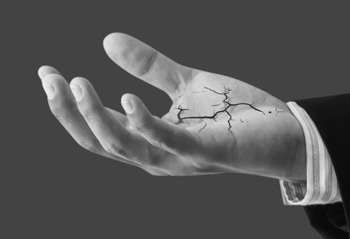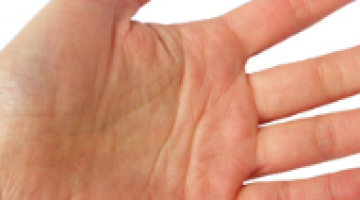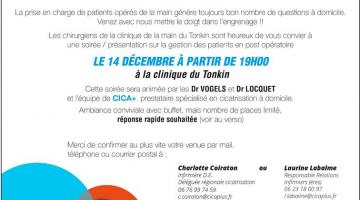responsive
Causes and symptoms
 The cause of this disease is unknown. It affects the tissue (aponeurosis) which protects muscles, nerves and blood vessels.
The cause of this disease is unknown. It affects the tissue (aponeurosis) which protects muscles, nerves and blood vessels.
This tissue thickens and forms a nodular shape, which causes wrinkles in the palm or fingers.
As the disease progresses, the tissue retracts, forming cords. These cords prevent the hand from straightening fully. Closing the hand can still be possible, as the tendons continue to be in good condition.
In the most serious cases, fingers can be locked in a permanent flexion.
The ring and the little finger are the most affected by this condition,but it can affect the whole hand. The disease is usually painless.
This condition is partially genetic: other members of the same family are often affected with other types of this condition.
The most severe forms of this condition appear on feet as plantar fibromatosis (Ledderhose´s disease),on the male genitals (Peyronie´s disease) or on the back of the fingers.
The earlier this condition appears, the more serious it is; in general it appears in men at about fifty years of age, and later in women.
Other related diseases
Several conditions are related to Dupuytren´s disease: Epilepsy, diabetes, hypertriglyceridemia, alcohol use and smoking.Dupuytren's disease is never caused by hand-use, however the condition can manifest as a result of an accident, under certain conditions.

Symptomes
responsive
Traitment
Currently, there is no therapy to prevent this condition occuring The only possible treatment is cutting or removing the affected tissue.
As the origin of the condition is unknown, surgery alone cannot prevent the disease from spreading to other fingers or prevent the condition recurring in fingers that have already been operated on.
Early forms of the condition are hardly ever treated. However, treatment must not be delayed as severe forms are more difficult to treat and the risk is higher.
Outcomes will not be as good as expected and the risk of recurrence is higher.
Outcomes will also be worse if the little finger or finger articulations are affected.
Usually, we recommend therapy if patient cannot fully stretch his/her hand on a table by pressing it with the other hand.
There are several forms of treatment available depending on the seriousness of the disease and on the patient. Complications can arise due to weakened skin resulting from this condition, and due to the presence of nerves and blood vessels close to the affected area.
Patient, une prise en charge axée sur
Traitement
Three types of traitment
Cord Sectioning
This treatment involves a simple sectioning of the cords with the tip of a scalpel, bevel or needle. It is the first known treatment created by Dupuytren himself. The technique is very simple and patients can start using their hand again quickly. Often patients must wear an orthesis for several weeks. During the procedure there is a risk of blood vessels, nerves or tendons being damaged. Cord sectioning is especially indicated when the cords are only superficially under the skin, or subcutaneous. As a consequence, this treatment may not be suitable for every patient. As the disease is not eliminated by this procedure, there is a higher recurrence rate in comparison with other techniques.
Removal of cords
This surgical procedure lasts between 30 minutes and 2 hours, depending on the extent of disease. Usually, local anaesthesia is used, and hospitalisation is not necessary. Incisions need about three weeks to heal properly and they will be swollen for several weeks. In some cases, the surgeon might leave one section open to avoid complications such as bruising or skin pain. In this case, healing will then take longer (six to eight weeks), but often it will be less painful. Usually, it will be necessary to do some physiotherapy, and to wear a splint to fully stretch the fingers. It is difficult to section those areas in contact with nerves and blood vessels; nerves are sometimes irritated, provoking a tingling sensation in the fingers. This sensation can last for several months. It is also possible to section a nerve or an artery. The fingers might remain stiff, especially the little finger. The risks of infection and recurrence are equally present. These are only some of the possible complications that may occur.
Removal of cords and skin with a skin graft
Removal of cords and skin is performed with a skin graft or a flap This is a longer and a more ambitious technique. Recurrence of the disease after a graft is rarer compared with other techniques, but the aesthetic impact is bigger. This technique is offered to patients suffering from more serious forms of the condition or those whose condition has recurred after surgery. The healing process takes longer, however the complications are the same as for the previous technique.
Follow up and possible after-effects
f surgery is recommended, the patient will be on sick leave for at least a month or more in some cases. Other forms of treatment are possible but are rarely indicated.
Treatment will be adapted to every particular case.
After- effects may include: residual pain, some stiffness of the fingers and / or wrist, or even in the shoulder.Many patients seek treatment too late when their fingers and articulations are stiff. It is then sometimes impossible for surgeons to fully stretch the patient´s fingers.
Your surgeon is the best person to answer any questions you might ask about this condition before and after an operation. Do not hesitate to talk to him/her again before making a decisio





